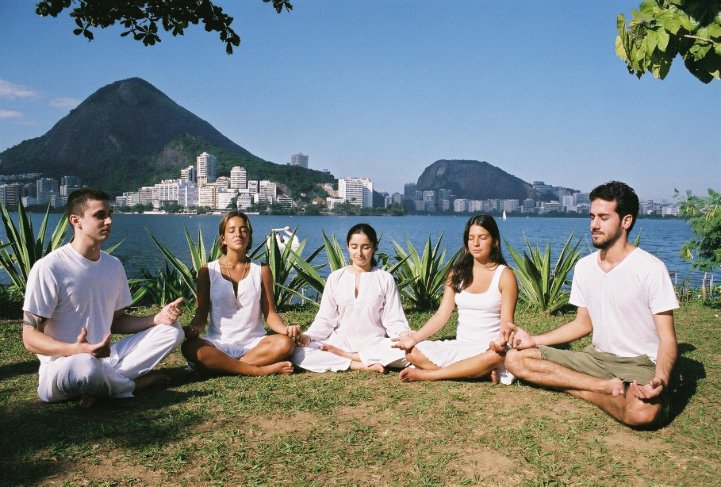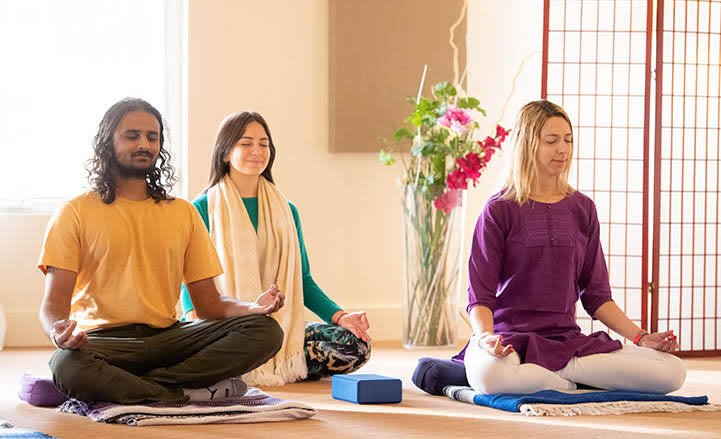
Benefits
Learn how SKY Breath Meditation from the Art of Living reduces stress and anxiety through science-backed breathing techniques and research. Read now.
Stress and anxiety are two of the most common challenges people face today. Whether it’s work deadlines, financial worries, global uncertainty, or even the constant ping of notifications on our phones, modern life often demands more from us than our minds and bodies can comfortably handle. As a result, stress levels continue to rise, leaving many people searching for solutions that go beyond quick fixes.
Exercise, therapy, and medication are common ways to manage stress—and all of them can help. However, in recent years, one practice has gained global recognition for its powerful and measurable impact on mental health: SKY Breath Meditation.
Developed by the Art of Living Foundation, SKY (short for Sudarshan Kriya Yoga) is an evidence-based rhythmic breathing technique practiced by millions of people worldwide. Unlike general meditation, which often relies on silent focus or visualization, SKY works directly with the breath to restore balance to the nervous system, calm the mind, and build long-term resilience.
So, what makes this practice so effective? And why is the science behind it so compelling? Let’s dive in.
To understand how SKY works, it’s helpful first to explore why the breath is so closely linked to stress.
When we encounter a stressful situation, our body activates the fight-or-flight response. Stress hormones like cortisol and adrenaline are released, increasing heart rate, tightening muscles, and speeding up breathing. In small doses, this response helps us survive by making us alert and ready to act.
The problem is that for many people today, this survival response is triggered not by life-or-death events, but by everyday challenges—such as traffic, emails, arguments, or financial concerns. Over time, constant activation of this stress response leads to:
Now, notice your own breath:
This isn’t a coincidence. The state of your mind is mirrored in your breathing patterns. And here’s the key insight: unlike most automatic body functions (like digestion or heartbeat), breathing is both automatic and voluntary. You can’t directly tell your heart to slow down, but you can change your breathing—and by doing so, you influence your nervous system, emotions, and even your heart.
This is precisely what SKY Breath Meditation does. It harnesses the breath as a bridge between body and mind. By regulating the rhythm of the breath, SKY helps regulate stress responses at the deepest physiological level.

For more than three decades, scientists across the globe have studied SKY Breath Meditation. Their findings show measurable effects on the nervous system, stress hormones, brain activity, and emotional resilience.
Let’s look at what the research tells us.
SKY uses a unique sequence of slow, medium, and fast breathing patterns. This rhythm stimulates the vagus nerve, one of the longest nerves in the body, which plays a central role in calming the nervous system.
The vagus nerve activates the parasympathetic nervous system (PNS)—the “rest and digest” mode that counters the fight-or-flight response. When the PNS is activated:
SKY practitioners reported better sleep, improved focus, and reduced emotional reactivity within just a few weeks.
Cortisol is the body’s primary stress hormone. In short bursts, it’s useful—it gives us the energy to respond to challenges. But when cortisol levels remain high due to chronic stress, it damages the brain (especially the hippocampus, which regulates memory and learning) and weakens the immune system.
Research at Harvard Medical School and Yale University found that SKY practitioners had significantly lower cortisol levels compared to control groups. Lower cortisol means:
In other words, SKY doesn’t just make you feel calm—it literally resets your hormonal balance.
Brain activity can be measured using an EEG (electroencephalogram). SKY practitioners show a marked increase in alpha brain waves, which are associated with relaxation, creativity, and stable mood.
This is sometimes referred to as the “relaxed yet alert” state. It’s a sweet spot where you feel calm, but not drowsy—clear-headed, focused, and ready to engage with life.
What’s remarkable is that SKY allows even beginners to access this state within their first few sessions. That’s why many participants say things like, “I felt lighter after just one class.”
One of the most complex parts of anxiety is the sense that emotions are uncontrollable. SKY strengthens the prefrontal cortex, the region of the brain responsible for decision-making, impulse control, and emotional regulation.
With a stronger prefrontal cortex, you’re less likely to spiral into worry, snap in anger, or feel overwhelmed. Instead, you can respond thoughtfully, even in challenging situations.
The Center for Compassion and Ultruism Research and Education found that a one-week program for war veterans, featuring SKY, improved PTSD symptoms within a month of practicing SKY and continued even after one year.
If SKY can help people recover from extreme trauma, it’s no surprise that it also helps with the everyday stresses of modern life.
Managing stress isn’t just about calming down—it’s also about building resilience, so you bounce back faster when difficulties arise. SKY has been shown to increase levels of serotonin, a neurotransmitter associated with happiness and well-being.
Regular practitioners report:
A randomized controlled trial at the University of Arizona confirmed that SKY participants developed greater stress resilience compared to those practicing mindfulness meditation alone.

Science provides the evidence, but the most compelling proof comes from personal experience. Practitioners often report:
Imagine waking up refreshed, handling challenges calmly, and feeling emotionally steady throughout the day. For millions of practitioners, that’s the reality SKY helps create.
| Practice | How It Helps | SKY’s Advantage |
| Exercise | Reduces stress hormones, boosts endorphins | Works even without physical strain |
| Mindfulness Meditation | Builds awareness and calm | Uses the breath as a direct, active tool |
| Yoga Postures | Relaxes muscles and improves flow | Goes deeper into emotional regulation |
| Medication | Alters brain chemistry | Natural, with no side effects |
All stress-management practices have value. Exercise strengthens the body. Mindfulness sharpens awareness. Yoga improves flexibility and calm. However, SKY uniquely combines physiological, emotional, and cognitive benefits into a single, integrated approach.
If you’re curious but not yet ready to dive fully into SKY, here are a few steps you can try today:
Learn SKY Properly: To experience maximum benefits, learning the SKY technique with certified instructors is essential.

The Art of Living Foundation offers SKY Breath Meditation workshops worldwide, both in-person and online. In these sessions, certified instructors guide participants step-by-step through the breathing practices, ensuring the practice is safe, effective, and providing personal support.
To learn SKY:
Stress and anxiety may seem like inevitable parts of life today, but science shows we have the power to change how we respond. By consciously working with the breath through SKY Breath Meditation, we don’t just calm the mind temporarily—we rewire the nervous system, rebalance hormones, and strengthen the brain for greater resilience.
Backed by decades of research and embraced by millions worldwide, SKY brings together ancient wisdom and modern science in one transformative practice. In a world that never stops moving, SKY offers a reminder that balance is always as close as your next breath.
✨ The research is clear—SKY Breath Meditation reduces stress, boosts resilience, and restores balance. But the real transformation happens when you practice it for yourself.
👉 Join the Art of Living Part 1 Course and learn SKY Breath Meditation step by step in a guided, supportive environment. In just a few sessions, you’ll discover how your own breath can unlock calm, focus, and lasting well-being.
💡 Still have questions about SKY Breath Meditation?
We’ve answered some of the most common ones below so you can feel confident about getting started.












